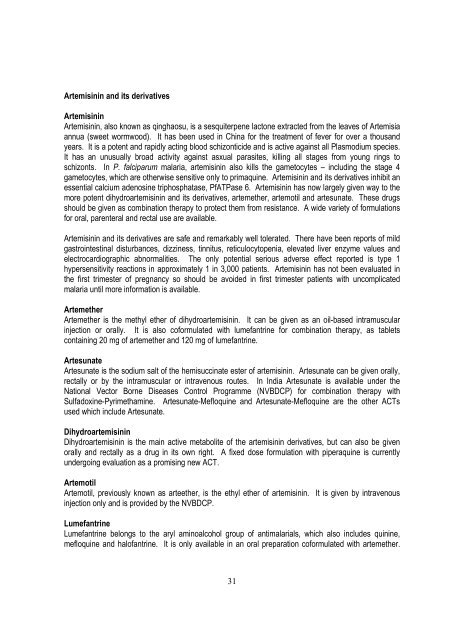training module for medical officers primary health centre - NVBDCP
training module for medical officers primary health centre - NVBDCP
training module for medical officers primary health centre - NVBDCP
- No tags were found...
Create successful ePaper yourself
Turn your PDF publications into a flip-book with our unique Google optimized e-Paper software.
Artemisinin and its derivativesArtemisininArtemisinin, also known as qinghaosu, is a sesquiterpene lactone extracted from the leaves of Artemisiaannua (sweet wormwood). It has been used in China <strong>for</strong> the treatment of fever <strong>for</strong> over a thousandyears. It is a potent and rapidly acting blood schizonticide and is active against all Plasmodium species.It has an unusually broad activity against asxual parasites, killing all stages from young rings toschizonts. In P. falciparum malaria, artemisinin also kills the gametocytes – including the stage 4gametocytes, which are otherwise sensitive only to primaquine. Artemisinin and its derivatives inhibit anessential calcium adenosine triphosphatase, PfATPase 6. Artemisinin has now largely given way to themore potent dihydroartemisinin and its derivatives, artemether, artemotil and artesunate. These drugsshould be given as combination therapy to protect them from resistance. A wide variety of <strong>for</strong>mulations<strong>for</strong> oral, parenteral and rectal use are available.Artemisinin and its derivatives are safe and remarkably well tolerated. There have been reports of mildgastrointestinal disturbances, dizziness, tinnitus, reticulocytopenia, elevated liver enzyme values andelectrocardiographic abnormalities. The only potential serious adverse effect reported is type 1hypersensitivity reactions in approximately 1 in 3,000 patients. Artemisinin has not been evaluated inthe first trimester of pregnancy so should be avoided in first trimester patients with uncomplicatedmalaria until more in<strong>for</strong>mation is available.ArtemetherArtemether is the methyl ether of dihydroartemisinin. It can be given as an oil-based intramuscularinjection or orally. It is also co<strong>for</strong>mulated with lumefantrine <strong>for</strong> combination therapy, as tabletscontaining 20 mg of artemether and 120 mg of lumefantrine.ArtesunateArtesunate is the sodium salt of the hemisuccinate ester of artemisinin. Artesunate can be given orally,rectally or by the intramuscular or intravenous routes. In India Artesunate is available under theNational Vector Borne Diseases Control Programme (<strong>NVBDCP</strong>) <strong>for</strong> combination therapy withSulfadoxine-Pyrimethamine. Artesunate-Mefloquine and Artesunate-Mefloquine are the other ACTsused which include Artesunate.DihydroartemisininDihydroartemisinin is the main active metabolite of the artemisinin derivatives, but can also be givenorally and rectally as a drug in its own right. A fixed dose <strong>for</strong>mulation with piperaquine is currentlyundergoing evaluation as a promising new ACT.ArtemotilArtemotil, previously known as arteether, is the ethyl ether of artemisinin. It is given by intravenousinjection only and is provided by the <strong>NVBDCP</strong>.LumefantrineLumefantrine belongs to the aryl aminoalcohol group of antimalarials, which also includes quinine,mefloquine and halofantrine. It is only available in an oral preparation co<strong>for</strong>mulated with artemether.31
















